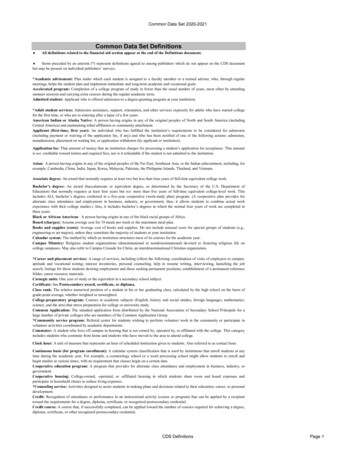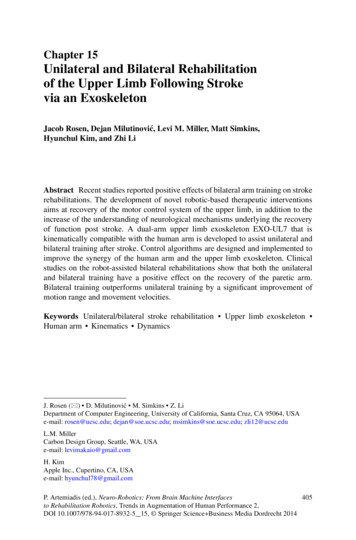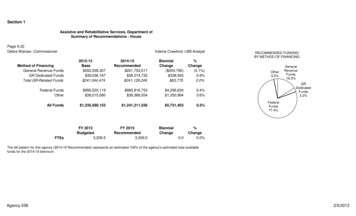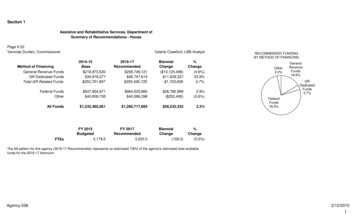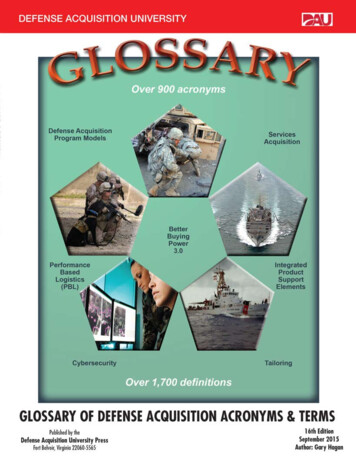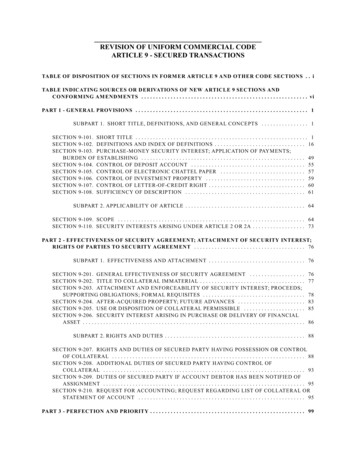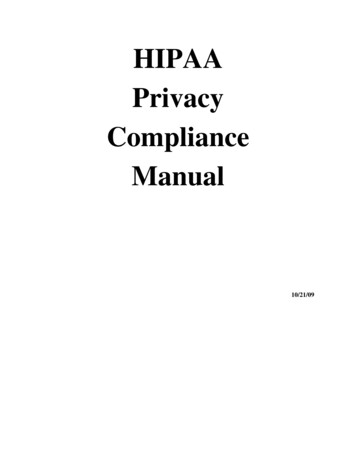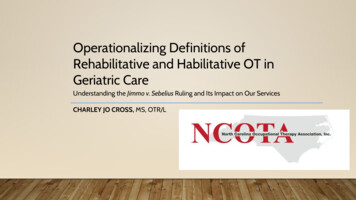
Transcription
Operationalizing Definitions ofRehabilitative and Habilitative OT inGeriatric CareUnderstanding the Jimmo v. Sebelius Ruling and Its Impact on Our ServicesCHARLEY JO CROSS, MS, OTR/L
INTRODUCTIONSCHARLEY JO CROSS, MS, OTR/L UNC Chapel Hill 2018 Graduate First year practitioner Currently working in SNF supervisingthree COTAs
ICEBREAKER Let’s go around to introduce ourselves Name Practice Area Years of Practice
OBJECTIVES Review Medicare definitions of rehabilitative and habilitative services Develop understanding of skilled intervention and therapy that wouldbe classified as rehabilitative and habilitative Develop understanding of Jimmo v. Sebelius ruling and impact ondetermination of services Discuss coding and language use to improve documentation
“A type of health care given when you need skilled nursing orrehabilitation staff to manage, observe, and evaluate your care. Nursing,physical therapy, occupational therapy, and speech therapy areconsidered skilled care by Medicare. In addition to providing direct carethese professionals manage, observe, and evaluate your care. Anyservice that could be safely done by a non-medical person (or byyourself) without the supervision of a nurse isn't considered skilledcare.”DEFINITION OF SKILLED CARERetrieved from https://www.medicare.gov/
“Healthcare services that help a person keep, get back,or improve skills and functioning for daily living thathave been lost or impaired because a person was sick,hurt, or disabled.”DEFINITION OF REHABILITATIVE SERVICESRetrieved from aota.org
AFFORDABLE CARE ACT – ESSENTIAL HEALTH BENEFITSA group of ten health services that must be covered by health insurance plans as mandated bythe Affordable Care Act. These include:1.Ambulatory patient services2.Emergency services3.Hospitalization4.Pregnancy, maternity, and newborn care5.Mental health and substance use disorder services, including behavioral health treatment6.Prescription drugs7.Rehabilitative and habilitative services and devices8.Laboratory services9.Preventive and wellness services and chronic disease management10.Pediatric services, including oral and vision careRetrieved from HealthCare.gov
“Healthcare services that help a person keep,learn, or improve skills and functioning for dailyliving.”DEFINITION OF HABILITATIVE SERVICESRetrieved from aota.org
“Habilitative and rehabilitative services can involve the sameservices, provided in the same setting, to address the samefunctional deficits and achieve the same outcomes; the differenceis whether they involve learning something new or relearningsomething that has been lost or impaired.”CURRENT AOTA INTERPRETATIONRetrieved from aota.org
ADDITIONAL INFORMATIONCODINGREIMBURSEMENT Select CPT codes (same that you wouldfor rehabilitation services) – usemodifiers so that the insurancecompany can distinguish whichrationale is guiding services There is no difference inreimbursement rate betweenrehabilitative and habilitative services As of January 1, 2018 the modifiers nowin effect are 96 and 97 These modifiers make it easier to trackand enforce the limit requirements forrehabilitative and habilitative servicesRetrieved from icd10.comAccording to AOTA Regulatory Affairs
CONCEPTUAL MODELTherapy Is the clientappropriate foroccupationaltherapy?Goals What goalsshould be thefocus oftherapy?Methodofdelivery Willrehabilitative orhabilitativeservices berequired to meetthe client’sgoals?
In small groups with the people around you let’sconsider the following for 10-15 minutes and thenwe will discuss further as a large group:GROUP BREAKOUT What interventions used in your daily practice areusually new to your clients? How might rehabilitative delivery of theseinterventions look different from a habilitativedelivery? What barriers could make implementation of thisinformation into our practice difficult?
HELPFUL CONSIDERATIONSREHABILITATIVEHABILITATIVE Has the client experienced an illness orinjury impacting functional mobility,safety, or independence? Does the client have any experience withthe information/activity or is it new? Does the client have potential to return toa prior level of function? Has the client completed Med A stay buthave potential to continue to makeprogress towards a prior level of function? Does the client need additional services tolearn new information that will improvesafety awareness, prevent future healthproblems, or enhance quality of life andwell-being?
THEN THERE WAS JIMMO In 2013, the U.S. District Court for the District of Vermont approved the JimmoSettlement Agreement which deemed the “improvement standard” illegal siding withGlenda Jimmo et al against Kathleen Sebelius. In this case, the Center for Medicare Advocacy (CMA) successfully argued thatMedicare claims were being denied on the basis of a lack of restoration potential eventhough the individual did require a covered level of skilled therapy in order to preventor slow loss of functioning due to a medical condition.Retrieved from aota.org, 2013
FURTHER INFORMATION FROM CMS Medicare coverage of services should be based on the need for skilled care andevaluated reasonableness/need for various services to meet the individual’s healthgoals Therapy can be reasonable and necessary if it has potential to prevent or slowdeterioration of skill, independence, or health CMS revisions clarify that coverage of SNF, HH, OPT settings “does not turn on thepresence or absence of a beneficiary’s potential for improvement, but rather on thebeneficiary’s need for skilled care.”DOES NOT EXPAND COVERAGE BUT CLARIFIES EXISTING POLICYRetrieved from cms.gov/.Jimmo-FactSheet.pdf
CASE STUDIES
INITIATING SKILLED MAINTENANCE SERVICES Has the resident maximized their restoration of skill with therapy but risk regression ofskill if therapy is discontinued? What is needed to maintain level of function achieved in therapy? Are you sure this can be maintained by the client or caregiver? What is skilled about the maintenance that requires a licensed professional to continuetherapy? Has the resident experienced a change in health status due to a progressive disease orunexplained consequence of aging that does not show signs of significantimprovement with medical intervention?
Therapy is not one size fits allWHY DOES IT MATTER? Limiting the profession Missed opportunity Maximize our value (PDPM)
Recognize the needHOW DO WEADVOCATE CHANGE? Do your research Find the support Ask questions Remain loyal to your clients
POWERFUL DOCUMENTATION Be extremely clear about whyrehabilitative vs habilitative services havebeen determined as appropriateaccording to clinical reasoning and CMSdefinitions/guidelines. Explain why skills of a therapist areneeded to maintain level of function,quality of life, or safety. Measure progress and outcomes in a waythat reflects each service appropriately.KEY WORDS Maintain/Keep Prevent/Slow Stable Restore/Regain Implement Learn/RelearnRetrieved from aota.org, 2015
CONNECT TO OUTCOMES THAT ARE GOOD FORALL Fewer re-hospitalizations Less regression Improved quality of life Achievement and maintenance of highest level of functioning Ability to remain at most independent level on continuum of aging Decreased cost to healthcare system overall
GROUP BREAKOUT In pairs or groups of three, let’s create anaction plan for implementation ofinformation from this session and considerwhich clients may benefit the most fromhabilitative services or the Jimmo vs SebeliusRuling. Take 10-15mins to write down somenotes to take with you from this sessionand then we will discuss further as a largegroup.
FINAL WORD It is imperative that we determine and prescribe ourservices ethically, with justice, and as effectively aspossible so that outcomes can accurately reflect ourimpact on health, independence, and well-being. We need to appropriately differentiate betweenrehabilitative and habilitative services and advocate foracceptance of skilled maintenance with older adults asthis is so important to quality of life and our mission as aprofession to help all people live the life they desire.
PLUG Please take the feedback survey that willbe sent out about this session.
QUESTIONS?Please feel free to contact me with additional questions.charleyc301@gmail.com
American Occupational Therapy Association (2018). New CodingRequirement for Billing Habilitative and Rehabilitative Services in SomePrivate Insurance Plans. Retrieved ican Occupational Therapy Association (2015). Jimmo: The Court CaseThe Promotes Skilled Therapy. Retrieved lled-therapy.aspxREFERENCESAmerican Occupational Therapy Association (2013). Jimmo v. Sebelius: Theso-called Medicare “Improvement Standard” Deemed Illegal, SkilledMaintenance Care Now Covered. Retrieved ican Occupational Therapy Association (2017). Enhanced CMS Trainingand Education Required to Support Maintenance Therapy. Retrieved an Occupational Therapy Association (2015). Tips for Maximizing YourClinical Documentation. Retrieved imize-clinical-documentation-tips.aspx
Jimmo v. Sebelius Settlement Agreement Fact Sheet. Retrieved dfREFERENCESJimmo vs Sebelius Settlement Agreement. Case 5:11-cv-00017-cr Document 82-1 Filed10/16/12 Page 1 of 32. Retrieved oads/2012/12/Settlement-Agreement-for-Web.pdfJimmo v. Sebelius Settlement Agreement Program Manual Clarifications Fact Sheet.Retrieved ealthcompare/Resources/Glossary.html
IMAGE REFERENCESAbsolutely no copyright infringement wasintended by creators of this presentation.All credit to owners of images. pdf iggest-list-ever/ ok-with-being-ok-to-become-great-e3a8caa6f33e -nursing-facility iving-facility-florida.html d2d5a1ccdc12984fa57bb3.jpg living-levels-of-care/ https://www.thriveglobal.com/tags/goals?page 3 nt/ aks-are-more-effective-than-others-1495047625 ls/work-groups/ the-puzzle?sort mostpopular&mediatype photography&phrase final%20piece%20of%20the%20puzzle ivity ideas.html plicants-references/
Review Medicare definitions of rehabilitative and habilitative services Develop understanding of skilled intervention and therapy that would be classified as rehabilitative and habilitative Develop understanding of Jimmo v. Sebelius ruling and impact on determination of services Discuss coding and language use to improve documentation
